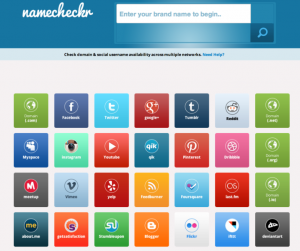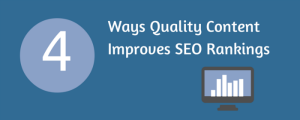There are lots of lists of business blog ideas out there. I’ve done one before, myself. But I realized there was something missing from those ubiquitous lists:
WHEN are you supposed to use each kind of post?
I suppose, if you’re just out trolling the Internet because you have blogger’s block and have no idea what to write about, a straight up list of a bunch of business blog ideas might be useful.
But what about those of you who want to do more with your business’ blog than just post something every week? (If that’s you, you’re one of my peeps. HELLO!)
That’s why I decided to not only update my previous list of business blog ideas — and more than triple it in size, in the process — but also group and categorize them for you based on where you are in your sales cycle.
Business blog ideas based on your sales cycle — the short version.
I could spend entire blog posts talking about this (oh wait — I have), but here’s the short version of choosing business blog topics based on your sales cycle:
There are two cycles you need to be aware of. First is your sales or launch cycle. I like to think of your business’ blog as a long-form sales letter dripped out over time. You’re leading people down a predetermined path, grabbing their attention, holding their interest, generating desire, and asking them to take action. If you do this regularly with your blog you will sell more. Easy as that.
The second cycle is the customer awareness spectrum or process. Each potential customer out there goes through the same process of increasing awareness of the problem you solve and how you solve it. They start out completely unaware that they have a problem or that there is even a solution for that problem, then move to problem awareness, solution awareness, and finally awareness (and hopefully brand loyalty) to you. The very last stage happens after they have become a customer.
If you plan out and write your blog posts based on these two cycles, you will make more money with your blog because you will be reaching out to people with the information they need, when they need it.
Customer is Unaware — Use Attention Posts
When your potential customer is unaware, they may not even be aware that they have a problem, or the problem may not be top of mind for them. Even potential customers with urgent problems may not know that help exists.
That’s why you want to use ATTENTION posts at this stage to draw attention to the problem, your business, your brand, and your solution.
Posts at this stage should: Entertain, engage, and empathize with the reader.
- offer a white paper/special report [EPIC]
- share your manifesto [EPIC]
- write connection content — makes a connection between you and another post/blog
- see things from different angle/different audience — try to interest someone else’s audience with what you have to say
- interview frenemies (or profile bigwigs) [EPIC]
- write a link round-up
- share reviews of other products/services
- host blog carnivals/linkups
- host a challenge
- influential people round-up post — ie: 35 graphic designers to watch in 2016
- share an over-the-top generous free-resource post — make a list of all of YOUR free resources, or of all the free resources you can find out there [EPIC]
- share an (almost) too good to be true results post — this is like a case study, but with a crazy click-bait headline like, “How I Grew My Email List 1547% in Two Days!” (could also be a desire post)
- write a soul-baring personal post
- write the “Ultimate Guide” post — create the ultimate guide to *something* that your audience is interested in; Neil Patel of Quicksprout is the master of this [EPIC] (also an interest post)
- create controversy — not my personal favorite, but if you can stir the pot, you can garner a lot of attention
- answer a question no one else in your industry is answering
- “What other people are saying about X”
- What if X? (try to find something outrageous to draw attention, like what if the Internet had never been invented) [EPIC]
- write a parody post
- cheat sheets and quick reference guides
- create and share a checklist
- create and share an infographic
- moderate a debate between two experts — if there are two experts in your niche who disagree, lay out both of their arguments and compare [EPIC]
- share your data (traffic stats, expenses, income, whatever) [EPIC]
- host contests, drawings, etc.
- give away freebies (logos, icons, printables, checklists etc.) [EPIC]
- share a presentation you gave (SlideShare, audio recording, etc.)
- share “where I’ve been” or “where I’m going to be” post of your speaking/blogging/whatever schedule
- live-blog a conference or event
- give kudos — X people doing it right, brands I love, etc.
- create an arch enemy for your industry [EPIC]
- write an opinion / editorial
- riff on things happening in the cultural zeitgeist: memes, holidays, current events, pop culture
- create sharable images
- share your autobiography
- answer a question from your email, comments section, or social media
- confess a weakness
- showcase a new product, app, or tool you purchased for your business and how you plan to use it
- profile an employee or partner
- answer your fan mail or hate mail
- explain a law or regulation that your reader needs to understand
- describe a law or regulation you wish existed for your industry
- share about legislation you support or oppose
- expose a scam [EPIC]
- share cool photos or videos (memes) that your readers will appreciate and want to share
- ask a question and start a discussion
- gush about your personal heroes
- raise awareness for your favorite charity
- share what you’re reading or what’s on your bookshelf
- do a “Cliff’s Notes” or executive summary of a book your readers would be interested in
- describe a local or industry event you attended (with photos!)
- create a wish-list of tools you wish were available for you or your industry
- transcribe or imagine a typical conversation between you and a customer
- …or a typical conversation between you and a vendor
- …or a typical conversation between you and a competitor (etc.)
- describe some changes you’d love to see in your industry
- talk about what you’ve learned in the past year
- answer the first question most potential customers ask you
- write an open letter to someone in your industry, in politics, in the media, etc. [EPIC]
- describe your typical day (or an employee’s typical day)
- make predictions — about your industry, trends, etc. [EPIC]
- revisit past predictions — did they come true?
- recap the past year
- if customers don’t know your solution exists, why or why not?
- list what you wish people knew about your product or service
- share and answer the five questions you get asked most often when you tell people what you do
- describe your work/life balance
- share who you are outside of work
- share the questions your children ask you about your work
- create a music video for your business or product
- draw or commission a cartoon about your business, industry, or work
- offer a weekly or daily round-up of interesting or important articles in your industry
- round-up your most popular content from the past month/year
- ask a question on a social media platform and share the answers
- conduct a poll and share the results
- feature guest posts from industry experts
- create a list of trends to be aware of or watch
- practice radical transparency — share secrets others won’t [EPIC]
- explore a hard truth or controversial idea [EPIC]
- add your thoughts or opinions to someone else’s popular post
- go behind the scenes somewhere readers don’t normally get to see — anywhere from your office to your factory, to the red carpet etc. [EPIC]
- create and give away an award
- be inspiring: share quotes, stories, videos, etc. that are inspiring to your readers
- write an A–Z of your industry [EPIC]
- create a quiz that gives your reader some insight (fun or useful)
- compile a glossary of terms in your industry
- share how your company got its name
- share a timeline of something in your business or industry
- craft a cheat-sheet that makes a difficult task easy
- EPIC posts—this one really straddles attention and interest if you do it right; please note that I’ve marked posts that could be [EPIC]
Customer is Problem Aware — Use Interest Posts
When your potential customer is PROBLEM AWARE, they know they have a problem, but they don’t know if there’s a solution or not. They may be actively searching to find a solution.
Posts at this stage should: educate, inform, and build a relationship with the reader.
These are INTEREST posts.
- raise your customer’s problem
- profile your typical customer or several different typical customer types
- agitate the problem—what happens when it doesn’t get addressed?
- describe how to identify if people have this problem, or how to self-diagnose the problem [EPIC]
- talk generally about the kinds of strategies people use to solve lower level problems
- convince people they have a problem
- “news at 11” posts
- new research and how it supports your product [EPIC] — Tim Ferris does this all the time, insinuating that new research supports what he knew all along.
- do hypothetical client work “how I would do SEO for J-Lo” or whatever (also attention) [EPIC]
- the problem is worse than you think
- list the benefits of solving this problem
- list things you should avoid if you have this problem
- tutorials/how-to articles — depending on your niche, you could write these til judgement day… [EPIC]
- describe what you have learned about the customer’s problem from building or iterating your product or service
- describe what you know about your customers before you work with them — and/or what it’s difficult to know
- list some products or services you’d like to create and ask for feedback
- share some ways that others in your industry are behind the times
- tell a story of a time when you referred a customer to someone else (and why)
- if you were to retire or sell your business today, what advice would you give the incoming boss?
- describe a “horror story” or close call and how you handled it
- share how you’ve addressed complaints — about your business or your industry — and changed someone’s mind
- before and after post
- ask me—solicit questions from readers and answer them
- start a debate or discussion post
- show examples of what not to do
- ROI reports based on actual customers [EPIC]
- community oriented posts: customer stories, ideas, feedback, lifestyles
- case studies [EPIC]
- explain how to choose a _________ (what you sell or do)
- personal discovery story: how you discovered/learned a lesson
- success story — how you or someone else succeeded [EPIC]
- failure story — how you or someone else failed (and learned from it) [EPIC]
- share the most common myths in your industry
- share the most common misconceptions about your product or service
- mistakes customers make when choosing a product or service in your industry
- good and bad habits of business owners in your industry
- common mistakes of other people in your industry — especially if you’ve had to clean them up
- describe how your business is different in other regions or countries
- explain different schools of thought in your industry, and highlight your own
- numerate the differences between someone just starting out in your industry versus someone with years of experience
- tell the story of the best suggestion you ever got from a customer and how you implemented it
- share the best advice you ever got from a mentor and how you implemented it
- tell the story of the “father” or “mother” of your industry and what you have learned from them or how the industry has changed
- explain how or why a current news story or media event is important — “What ____ Means for ____.” “Why _____ Matters for _____.”
- present original research [EPIC]
- showcase results of a comparison test, stress test, real-world test, etc. [EPIC]
- create a regular feature readers can count on: a tip of the week, customer of the week, review of the week, etc.
- write a series that breaks a complicated topic into multiple parts [EPIC]
- conduct and share market research [EPIC]
- describe how you came up with your product idea
- share the story behind your newest product or service from idea to launch
- share some statistics about your customers or people who share this problem
- describe an analogy or illustration that explains a difficult concept

Customer is Solution Aware — Use Desire Posts
When your potential customer is SOLUTION AWARE, they know that solutions exist to solve their problem, and they may be researching their best options.
Posts at this stage should: build trust and persuade.
These are DESIRE posts.
- eliminate objections in this phase
- describe an experience when you turned an unhappy customer into a happy one
- share testimonials
- X mistakes [your ideal customer] makes
- show the benefits of YOUR approach
- features — how your solution is different
- comparison post — compare how two solutions work (yours and someone else’s) and how they’re different (yours is better, right??)
- let them know that a more powerful tool exists than what they already know about
- illustrate what life would be like with your product
- watch for questions in emails or comments that indicate they might be willing to buy—and answer those questions in a post
- “What if you had the perfect solution to your problem?” post
- FAQ post
- SAQ (should-ask questions) post
- product demos (videos, photos, case studies, etc.)
- explain what you do is an art/science; why fewer people are doing it the way you do; why up and comers in your niche aren’t as experienced
- describe how close you are to your “10,000” hours (people believe spending 10,000 hours at something makes you an expert)
- describe your training in detail
- describe your story and how you got to where you are now
- describe your attention (obsession?) with customer service, attention to detail, safety, quality, etc.
- call out your competitors; what changes would you like to see in your industry (and how are you different)? [EPIC]
- lay out exactly how your customer could justify the investment in your product or service to herself, a spouse, or a business partner
- compare the cost of your product or service to something else the customer may be buying (my favorite example of this is a stylist who compared the cost of her course to 6 outfits you never wear)
- explain exactly why your costs are higher or lower than your competitors (be sure to lay out the benefits)
- list the pros and cons of working with a specialist vs. a “jack of all trades” (and make sure you come out on top — whichever you are!)
- list the questions you ask your customers
- describe the toughest part of the job for you
- describe the easiest part of the job for you
- describe what your customers struggle with — and how you help them overcome it
- describe your worst customer
- describe your ideal customer
- explain if you ever barter for your services and why or why not
- interview a customer
- share photos from a recent event — especially good if you have an event-based service or you can show your product in action
- publish guest posts from customers about their experience
- share your passion or vision, especially as it differentiates you from your competition
- share a sneak peek or announce a VIP experience
- record or transcribe and share a conversation or discussion your team is having
Customer is Aware of YOU — Use Action Posts
When the potential customer is aware of you and your solution, they’re almost ready to buy, you need to ask them to take action and make a purchase.
Posts at this stage should: engage the reader and convince them to become a customer.
These are ACTION posts.
- announce that a product is available or shopping cart is open
- direct them to a landing page
- remind people of all the steps leading up
- clear CTA post
- announce an event (like a webinar, conference call, etc.)
- describe your busy season (best paired with an offer to purchase before the busy season starts)
- explain when you turn away a potential customer and why
- describe any insurance coverage or guarantees for your product or service
- explain financing options for your services
- share an excerpt from the product
- share an excerpt from a webinar
Customer is a… Customer — Use Engagement posts
Of course, there are people in your audience who have already purchased from you, and you don’t want to neglect them, so continue to engage them with your brand and products.
Posts at this stage should: encourage two-way communication and advocacy.
These can also be DESIRE posts, if you remind people who are not customers why they want to become one.
- tip sheets
- user guides
- how-to guides
- care and maintenance of your product
- showcase unusual ways other customers are using your product
- ask for feedback
- introduce or showcase a loyalty program
- ask for referrals
- tips to get more from your product or service
- the most innovative or astonishing use of your product or result of your service you’ve ever seen
If you found this post useful, DON’T keep it to yourself! Please share it with your network!
Digital & Social Articles on Business 2 Community(49)
Report Post








